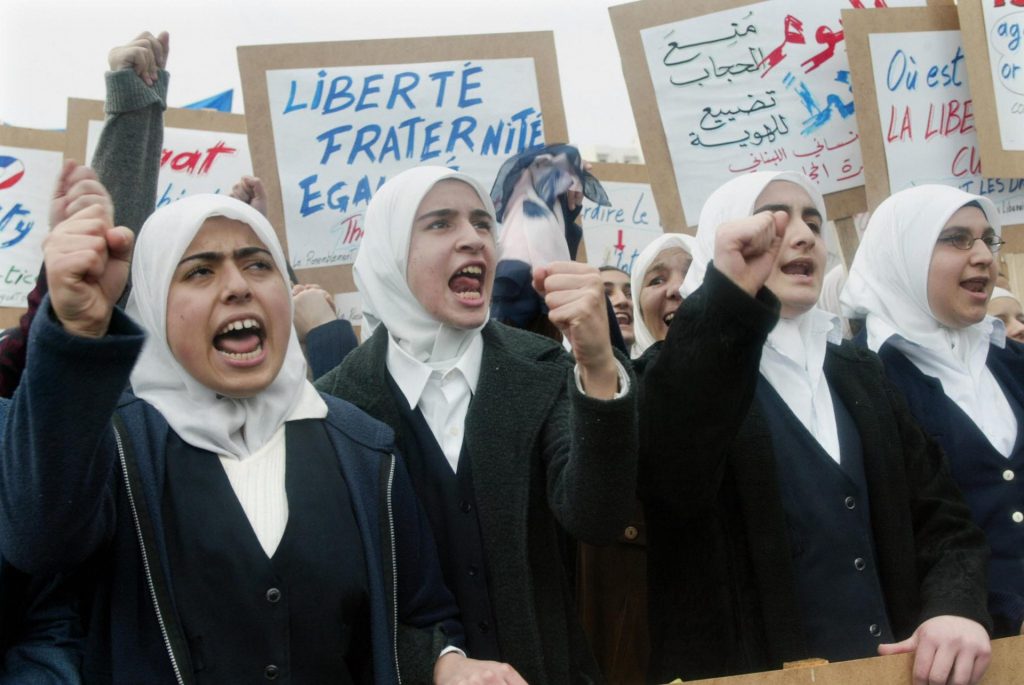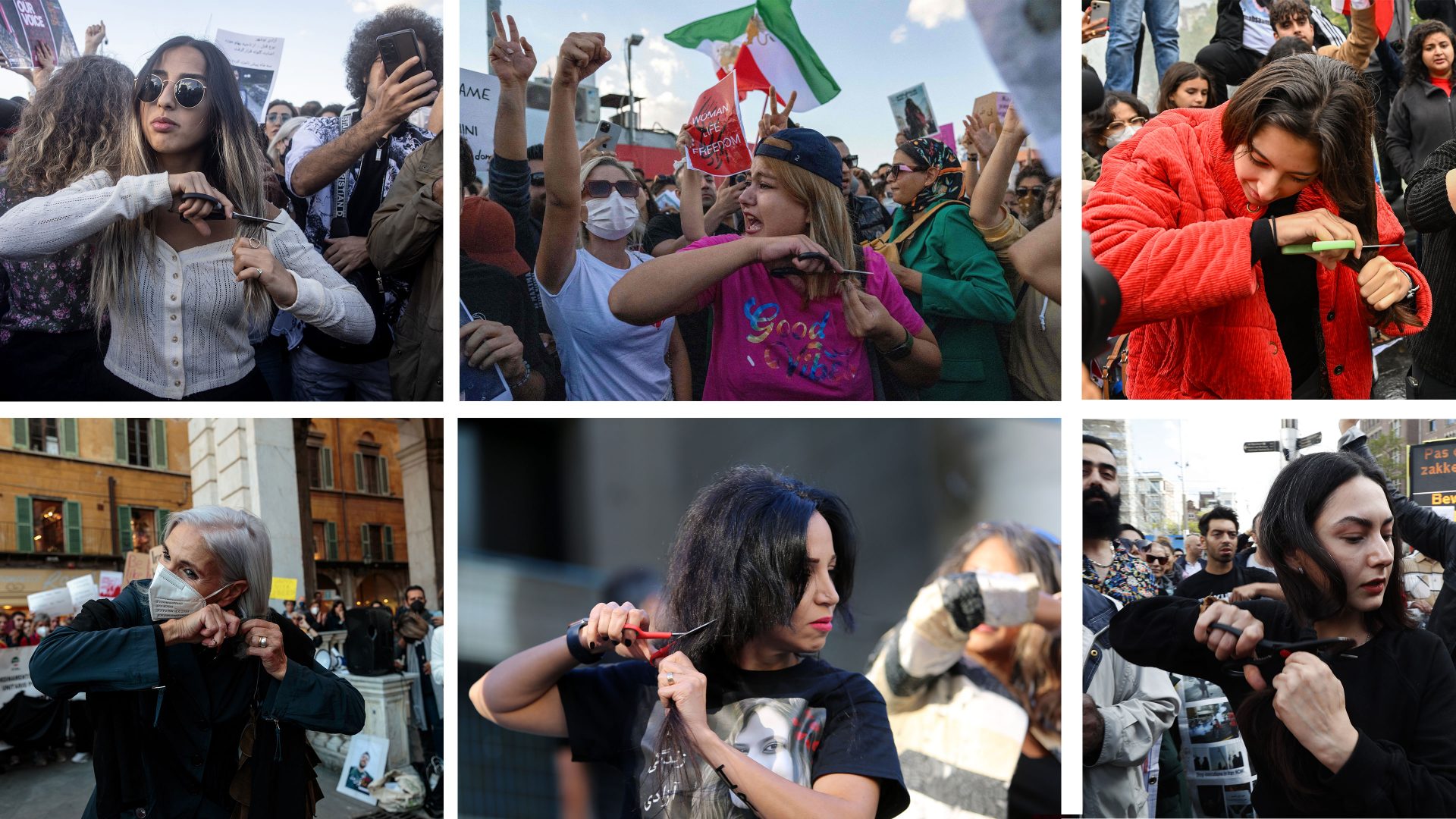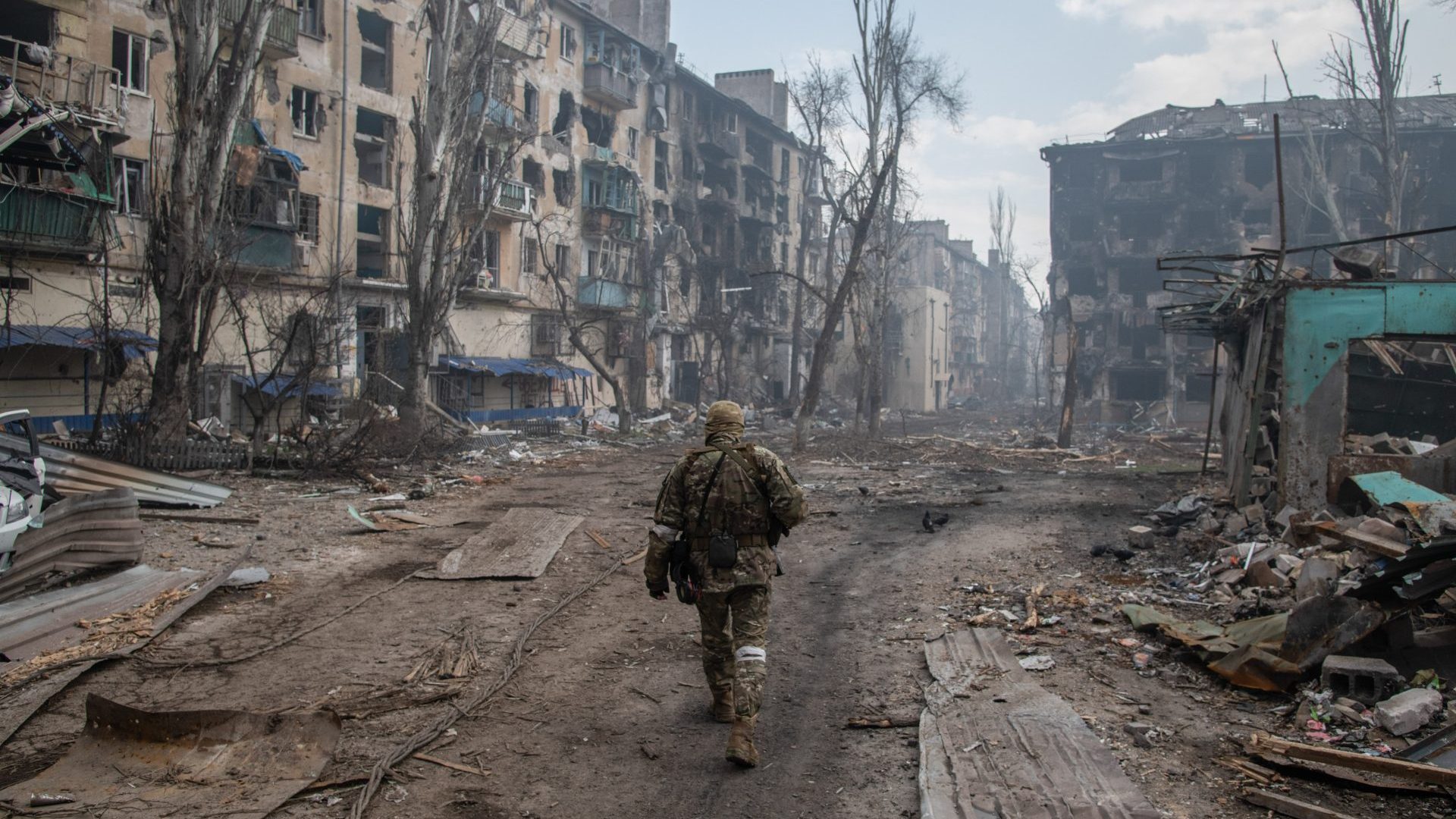It’s one of the most powerful scenes to emerge from the protests in Iran: a woman dressed all in white, her long black hair falling loose down her back, spins around beside a small bonfire, twirling faster and faster before flinging her headscarf into the flames and skipping away as the watching crowd cheers.
It’s an image that resonates for women who live in societies where their choices – about clothes, careers, where they go and so much more – are not directly controlled by the men in their lives, or by the state. To many of us, that young woman seems the very personification of a justified revolt against draconian repression.
But if the hijab – or headscarf – has become a symbol of state oppression in Iran, where girls aged over nine must cover their heads when in public, it means something entirely different to many Muslim women in France, where “conspicuous” signs of religious affiliation – for example, Muslim headscarves, Sikh turbans, Jewish skullcaps or large Christian crosses – have been banned in state schools since 2004.
As Iranian teenagers and women risk their lives to burn or discard their hijabs in public, young French Muslims are challenging the school ban because they want to be free to wear their headscarves or long loose-fitting robes, called abayas, in class. Some are posting TikTok videos about how to get round a law that supporters of laïcité would say is central to France’s identity as a secular republic.
In September, the education minister, Pap Ndiaye, said attempts to break the 2004 law by wearing religious clothing or signs had risen rapidly. Newspapers reported that there were over 300 challenges to the law in September, and this rose to 720 in October.
“I am aware of the fact that there may be instructions going out and proselytizing agitators who do not have good intentions as regards the schools or the pupils,” Ndiaye said.
Writing in Revue des Deux Mondes, the literary magazine’s director, Valérie Toranian, blamed the networks of the Muslim Brotherhood for trying to destabilise schools by encouraging those who want to challenge the law.
“The strategies are diverse: turning in class in a headscarf, refusing to take it off, creating incidents that are then spread on social media; demanding concessions for prayers; wearing burkinis for swimming sessions,” she wrote. “When Islamism is not reined in, it becomes harder and harder for Muslim women to oppose it. Those who say they protect their freedom have a republican duty to oppose political Islam, the Muslim Brotherhood and the Salafists. The battle is not just in Iran.”
Agnès De Féo would argue that what is happening in Iran has little bearing on how French Muslims view the hijab. The sociologist, who spent years interviewing Muslim women for her book Behind the Niqab, nonetheless sees parallels between the two protest movements, despite the obvious and glaring differences in scale and in the consequences for those involved.
“French Muslims will not take off their veils in solidarity with Iran. That would be bizarre,” she tells the New European. “We must recognise that (the hijab in France) is not so much a religious sign but is worn as a kind of protection and a sign of revolution in a hyper-sexualised society, by women who refuse to take part in a kind of marketplace for the body,” she said.
“When I discuss this with French people, even those around me, people really believe these women have a political agenda… They cannot imagine that they choose to wear the veil because it is a way for them to exist in society and achieve self-esteem because they have a sense of getting their revenge in a world where they are not in control. It is a way to reverse the relationship of domination.”
In this narrative, the two protests – to wear the veil and not wear the veil – might, at their most basic level, be said to be driven by the same desire: to free women from the repressive control of the state. It may seem trite to compare the social context facing hijab-wearers in Iran with the experience of those in France, but some argue there is an underlying parallel.
“It’s completely symmetrical. It’s the same system. (The women) have had enough of people controlling their bodies,” said De Féo.
“To be (hijabi) or not be (hijabi) is the business of no state or man,” Sudanese-Australian activist and author Yassmin Abdel-Magied wrote on Twitter in September. “Solidarity with women resisting patriarchal control, the world over.”
Rasha Al Aqeedi, an Iraqi-born journalist who now lives in Washington, questions the validity of drawing parallels between Muslim societies in western countries and the reality experienced by women in Iran. But she agrees that the fundamental issue is a woman’s right to choose.
“It’s really not against Islam or the hijab. It’s hard to explain when you’ve had choice all your life what it feels like to be deprived of having a choice in something that, literally, relates to you. I think today some women in America, with the whole abortion thing, can relate, but when it comes to something as basic as choosing to cover your head or not, or which college or university you want to study at, or what you want to be, whether you want to get married or not, choices that impact a woman’s life directly – not having a say in them is absolutely soul-crushing, and seeing that collapse (in Iran) is wonderful.”
The French president, Emmanuel Macron, has called secularism “the cement of a united France” and in essence, the idea of laïcité is supposed to encompass a commitment to religious neutrality and freedom of conscience. But some Muslims say the laws that emanate from this core ideology target their community – Europe’s biggest Muslim community – disproportionately.
The origins of this uniquely French concept, however, are rooted in France’s relationship with another religion. “The country’s history of religious conflict, and the outsized role of the Roman Catholic church therein, underlie why there is such an important attachment to the principle and belief that religion should be restricted to the private realm – an approach that is unparalleled elsewhere in Europe,” wrote the author Hannah Wallace in the Free Inquiry journal.
The separation of church and state was enshrined in French law in 1905, mainly to counter the influence of the Roman Catholic church. But more recently, as that church’s influence has waned, the advocates of laïcité have tended to focus their attention on the visible signs of Islam in public life.
“The greater visibility of religious affiliation among minority religions has come into conflict with secularism and its focus on religious neutrality in the public space and with the primacy of the citizen in the republic, where religion or ethnic affiliation is secondary and not a defining characteristic of membership of the republic,” Wallace writes.
In 2011, France became the first European country to ban all full-face coverings, including Muslim niqabs, in public places. The government argued the face-covering veils undermined the basic standards required for living in a shared society, but critics accused it of Islamophobia and seeking to marginalise Muslim women.
In 2016, some local governments sought to ban burkinis on southern beaches. Nicolas Sarkozy, who was running for the presidency again at the time, said wearing the full-body bathing suit was a “political act” and a “provocation”. France’s top administrative court later overruled the bans.
De Féo senses something sinister in the way the defence of France’s secularism has tended to focus on the clothing of Muslim women, and notably the hijab.
“This fear (of the veil) is rooted in anti-Arab racism. It’s a racism that has existed since the war in Algeria… In the 70s, 80s, and 90s, Algerians began to arrive in France, and their children began to affirm their connection to Islam by wearing the veil. People couldn’t accept that people from the former colony could arrive in France with the symbols that the colonial power wanted to change,” she said, adding that some people viewed the veil as a manifestation of the failure of the myth of French civilisation.
Recent history has served to entrench fears and hostility against the country’s estimated 5.7 million Muslims.
In 1995, Algerian Islamists from the GIA militant group bombed a series of train stations and other sites in Paris as they sought to drag the former colonial power into the Algerian civil war. Several people were killed and scores injured. In the mid-2000s, Islamic State carried out attacks across France, culminating terribly in 2015 with the attack on the satirical newspaper Charlie Hebdo, and coordinated attacks one November night at the Bataclan concert venue, the Stade de France and nearby restaurants, in which 130 people were killed.
The beheading of the schoolteacher Samuel Paty by a Chechen-born teenager in 2020 – apparently because the teacher showed cartoons of the Prophet Muhammad during a class on freedom of expression – led to another spike in tensions.
Macron described the murder as an attack on French values and the republic itself, and he insisted that France would not compromise on freedoms of belief and expression, angering Muslims worldwide and reinforcing the views of some French Muslims who believe secular laws are being used to quash their freedom to express their religious beliefs.
Last year, the French National Assembly approved an “anti-separatism” bill that critics say breaches religious freedom. Far-left leader Jean-Luc Mélenchon said the law, which includes measures on the neutrality of the civil service, the fight against online hatred, and the protection of civil servants such as teachers was “anti-Muslim”. The government said the legislation was needed to combat “Islamist separatism”.
This societal turmoil is not unique to France. In India, Muslim high school pupils went to court to challenge a ban on religious garments at a school in Karnataka state in the south of the Hindu-majority country. This month, the supreme court failed to deliver a verdict because the judges were split. The case now goes to the chief justice of India, who must decide whether a larger bench can make a ruling.
The Iranian protests and their deadly suppression by authorities have turned a global spotlight on the hijab. The demonstrations began after a 22-year-old Iranian Kurdish woman, Mahsa Amini, died on September 16, three days after she was arrested in Tehran by morality police, who claimed they detained her because of “inappropriate attire”. The police said she suffered a heart attack while in custody. Her family said she had bruises on her body when she died.
As the protests grew into one of the most serious challenges to the country’s religious leaders since the 1979 revolution, women outside Iran, including French actresses Juliette Binoche, Isabelle Huppert and Marion Cotillard, symbolically cut off pieces of their hair to show their solidarity. Isabelle Adjani also cut her hair, but came under fire after saying in a TV interview that Muslim women should take off their veils in solidarity with Iranian women. Adjani later clarified that she meant women should remove their veils temporarily as a symbolic gesture or protest.

De Féo says that some Muslim women in France already regard wearing the hijab as a revolutionary act – albeit without the deadly consequences suffered by Iranian protesters.
“The majority of the French, the majority of the pundits and analysts, think that women wear (the veil) in a traditional way to conform to the teachings of Islam, or to conform to family or societal expectations. But there is, of course, an element of rebellion, of subversion to oppose the authorities and above all the authorities at school,” says De Féo.
The sociologist said the women she interviewed for her book were anything but submissive. Many had wanted to be beauticians, models or hairdressers, but when they failed to meet the required beauty standards, they retreated behind their veils. Many had also been raped or sexually assaulted as children, and most were not particularly devout, possessing only a rudimentary knowledge of Islam.
Al Aqeedi, who is Middle East deputy editor at New Lines magazine, is uncomfortable with drawing too many parallels between the situation in France and that in Iran because the strictures in France come from a different place.
“The choice to wear or not to wear the hijab should never be politicised. That argument should not be happening. If you want to wear it, fine. In France, they don’t allow any religious symbols in institutions like schools and they look at the hijab as a religious symbol, not as a choice, and that’s a different debate.”
But she believes there is something more complex at play among some Muslim communities in the West, with second-generation Muslims sometimes “doubling-down” on this element of their identity, without understanding what it represents in the countries where their parents and grandparents originated.
“I feel there’s such a disconnect with second- and third-generation immigrants to Europe and America and the reality of life in Muslimmajority countries. They can afford to romanticise a reality that’s quite ugly because they are living in the West, they enjoy these freedoms. The reality for women in the Middle East – and I say this not being a xenophobe, I’m Muslim myself – it’s horrible and Muslim women living in the West would not tolerate it.”
Al Aqeedi, who was born in Mosul but now lives in Washington, does not wear the hijab, but she recalls her fight against social norms as a teenager and young woman living in Iraq.
“I respect anyone who wears it,” she says, “but I’ve always liked to debate things… and I wasn’t convinced when they told us, ‘you have to completely shield your hair and anything that adds some kind of appeal because you don’t know what the strange man in front of you is thinking. He might sexualise you’. I thought immediately, ‘that’s his problem’… I wasn’t convinced, and even religiously it didn’t make sense to me that the creator of this vast universe would have such a hang-up over a woman’s hair. It just didn’t sound logical to me. So I resisted.”
But her rebellion was ultimately doomed. After being called names and threatened at university, she finally gave in after she was hit by a stone thrown by an assailant who called her a slut as he ran away.
“It was scary and painful and that’s when I gave in and I wore the hijab and I wore it for as long as I remained in Iraq, about a decade after that incident. I left in late 2013 and the first thing I did, literally when I was en route to the airport in Erbil, I took it off and I just threw it out of the window,” the 38-year-old recalls.
Al Aqeedi recognises that the hijab means different things to different people – her mother and sister-in-law wear it, as do some of her friends. The key thing is that they have a choice, unlike the women in Iran, unlike her own younger self. For her, based on her experience, the protests in Iran are inspiring.
“I never protested in Iraq. I was too scared… And when I see these women taking off their hijab and standing and fighting it’s very, very inspiring. It’s a generational shift and change that I think our parents don’t really understand, but as the world grew more connected and closer this was bound to happen at some point,” she says. “I hope future generations look back at this as the turning point. I hope that when they talk of my generation and the generations before me, they think, ‘can you believe this is how women in our country used to live?’”
For De Féo, properly implemented secularism in France should protect Muslim women, and she says that the rules against conspicuous signs of religious affiliation should only apply to those working for the state, not to those they are there to serve.
“Those who are against the veil say, ‘this is a secular country and therefore we must ban the veil’. On the contrary, secularism protects veiled women… The freedom of conscience and the freedom to show one’s religion publicly and visibly is fundamental. It’s a treasure and very important. And those who oppose it are anti-democratic.”




